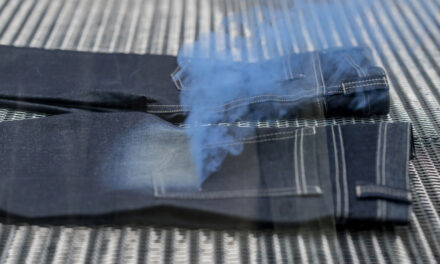Next in the defects article series, we are discussing about the defects found in the embroidery. Embroidery is used in garments to enhance their aesthetic appeal, but when defects appear in the embroidery itself, the quality of the garment deteriorates. Embroidery defects can be a result of irregularities in the stitches or the design or both. Based on the defect we can incorporate some remedial measures to counter their occurrence in the garment.
Poor registration:
This defect appears when the embroidery’s design and stitches don’t align correctly.
Causes
- Shifting of the fabric, the embroidery is being sewn into
Remedies
- Proper digitisation by using suitable underlay stitches
- Proper hooping by using backing to prevent flagging in the fabric
Fabric grin/gapping:
In this defect the base fabric is visible from the embroidery, either from between design or patterns or on the edge of the embroidery.
Causes
- The pull of thread is not compensated
Remedies
- Proper digitisation by use of appropriate underlay stitches, high stitch density, and using different fill pattern or direction of the stitches
- Thread’s Pull can be compensated by overlapping fill and satin border stitches
- Use of proper topping
Missed trim:
Appearance of extra embroidery threads left between patterns or other design elements in the embroidery.
Causes
- Lack of proper thread trims digitisation when moving from one point to another in the embroidery using jump stitches, or when changing the thread colour
Remedies
- Proper digitisation, using proper number of trims, appropriate tie-off stitches
- Replacing trimming knife when required
- Hand trimming the missed threads by trimming snips
Bunching at corners:
The corners of the design or letters in the embroidery are not crisp due to gathering up of thread at one point.
Causes
- Lack of proper digitisation leading to excess thread in the corners
- Wrong stitch selection
- Choosing wrong stitch length on corners
- Faulty stitch balance
Remedies
- Proper stitch selection
- Using stitches of shorter lengths on the design corners
- Monitoring and correcting stitch balance, i.e. the thread should not be too loose
Poor stitch balance:
In this defect, the bobbin thread shows up on the top side of the embroidery.
Causes
- Faulty needle thread tension
- Wrong thread selection
Remedies
- Using good quality pre wound bobbins
- Machine thread tension setting should be properly managed
- Proper needle thread selection
Fabric Damage:
Damage caused to the fabric due to repetitive needle penetration, especially around the corners of the embroidery.

Causes
- Incorrect needle size and type
- Repetitive stitches on a single spot on the fabric
Remedies
- Proper digitisation
- Managing stitch count in the corners
- Selecting correct needle type and size as per fabric
Thick embroidery:
Embroidery being too dense or thick at some places.
Causes
- Very high stitch density
- Improper backing used for the embroidery
Remedies
- Proper digitisation, ensuring correct stitch selection, and stitch density
- Use of shorter stitch length on corners
- Thread tension being properly balanced
- Thread size should be small
- Ensuring use of proper backing type and weight
Poor stitch density:
Base fabric visibility through the embroidery due to low stitch density.
Causes
- Low stitch density
Remedies
- Proper digitisation ensuring appropriate stitch selection, stitch density and underlay stitches
- Use of proper backing and topping
Poor hooping:
The fabric surrounding the embroidery gets distorted or crumpled and cease to lay flat on a surface.
Causes
- Use of wrong backing and/or topping
Remedies
- Ensuring use of proper topping and backing
- When hooping the fabric, it should not be stretched too much, as whenit gets relaxed when removed from the hoop, fabric will crumple
- Ironing hoop marks
Embroidery is generally used for logos or for adding design element to the garment. Ensuring embroidery’s quality thus becomes vital for the ensuring quality of the final garment. With the above information on the defects, their causes and remedies at hand, we can ensure minimum quality fallouts due to embroidery defects in our garments.























